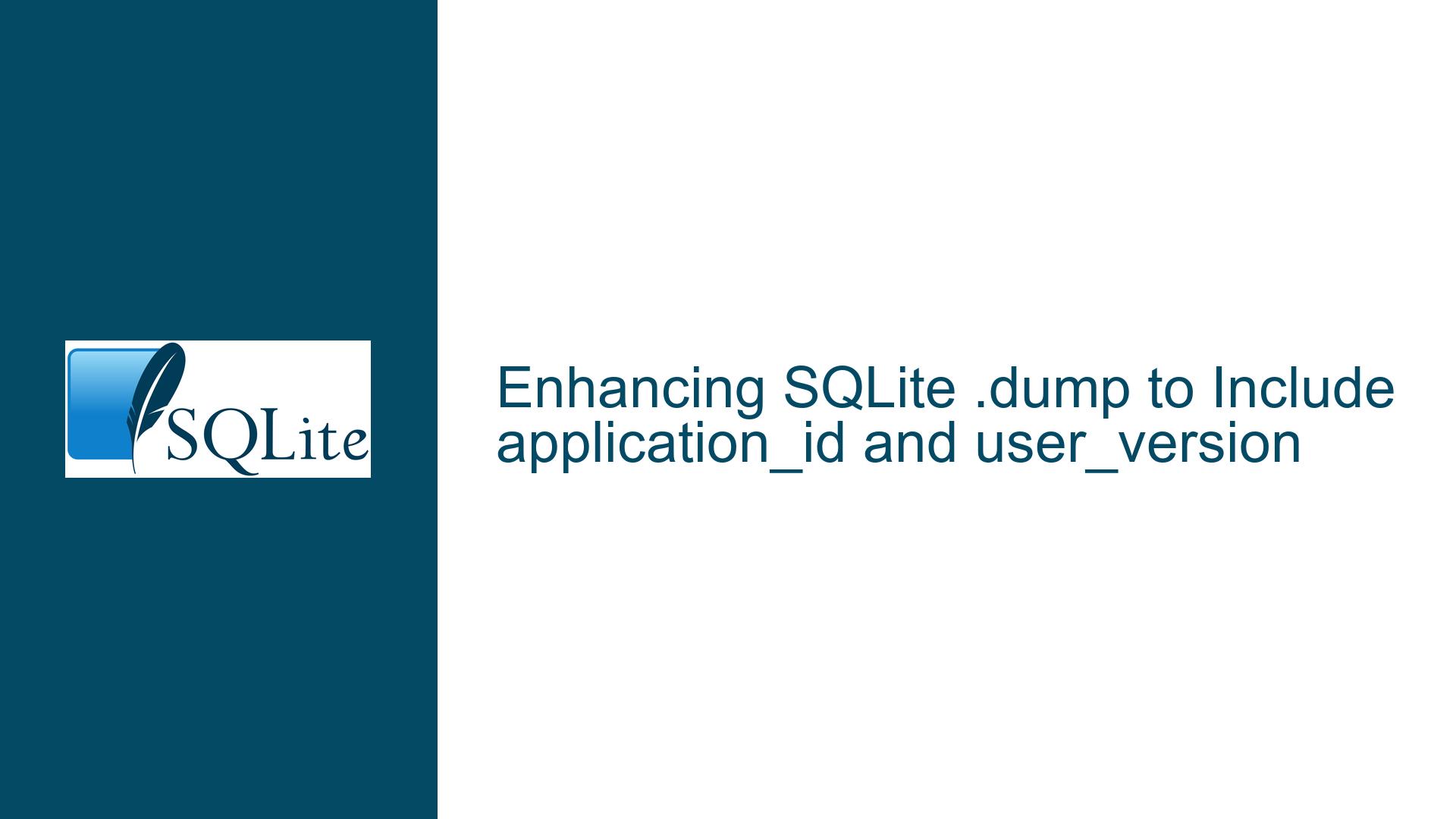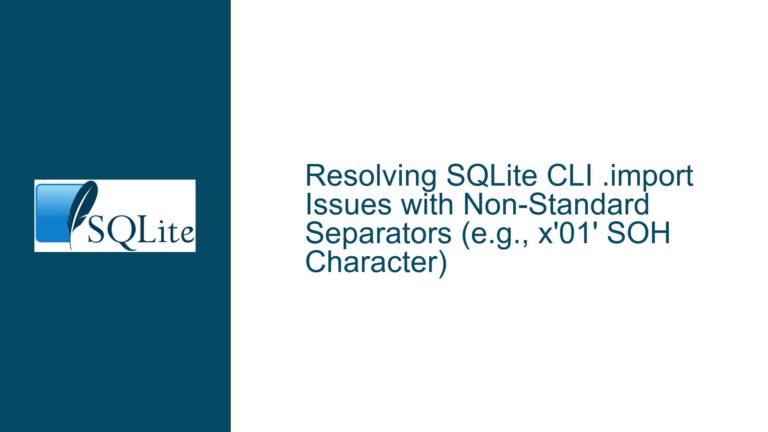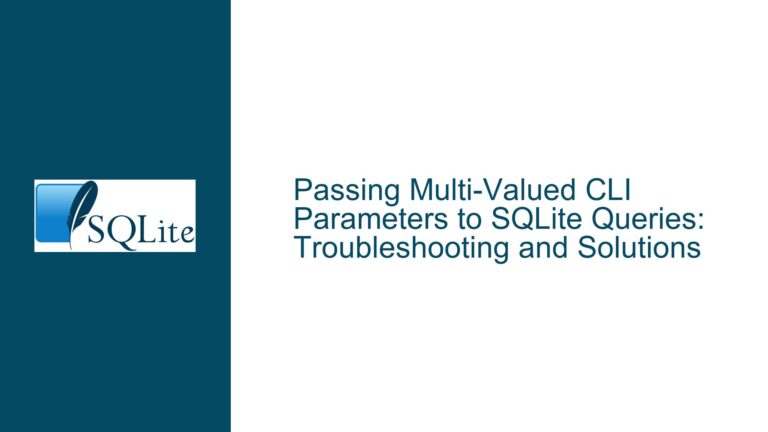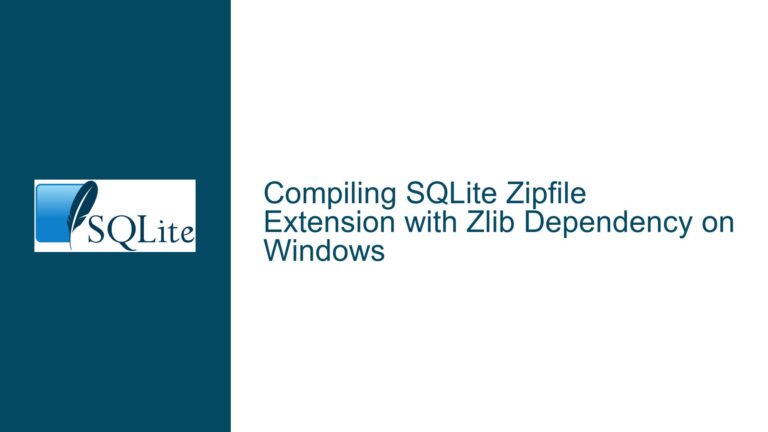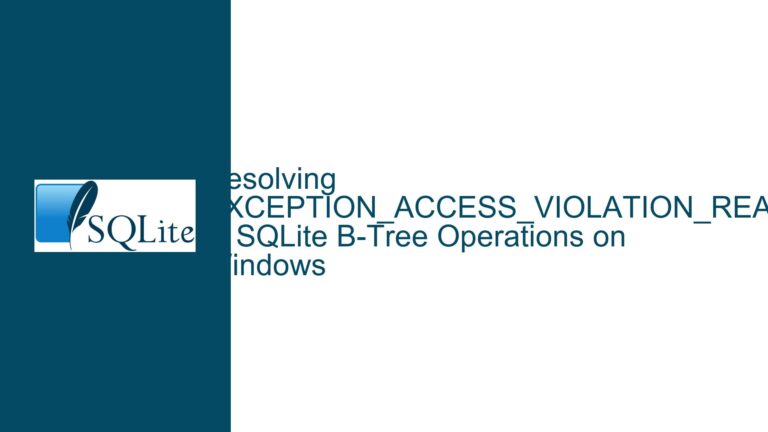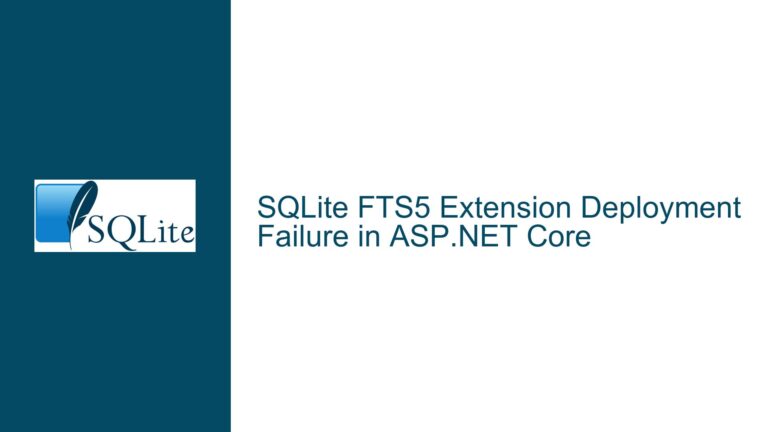Enhancing SQLite .dump to Include application_id and user_version
Issue Overview: Missing application_id and user_version in SQLite .dump Output
The SQLite .dump command is a powerful utility that generates a text file containing SQL statements necessary to recreate the database schema and data. However, the current implementation of the .dump command does not include the application_id and user_version pragmas in its output. These pragmas are crucial for certain applications, particularly those that rely on specific database configurations or compliance with standards such as the GeoPackage specification.
The application_id is a 32-bit signed integer stored in the database header, which can be used to identify the application that created the database. The user_version is another 32-bit signed integer stored in the database header, often used to track the version of the database schema. Both of these values are set using the PRAGMA command, and they are essential for ensuring that the database meets specific requirements, such as those outlined in the GeoPackage specification.
The absence of these pragmas in the .dump output means that when a database is recreated from a dump file, the application_id and user_version values are not restored to their original settings. This can lead to compliance issues, especially in applications where these values are critical for identifying the database or ensuring that the correct schema version is in use.
Possible Causes: Why application_id and user_version Are Omitted from .dump Output
The omission of the application_id and user_version pragmas from the .dump output can be attributed to several factors. First, the .dump command is designed to generate a set of SQL statements that can recreate the database schema and data. The focus of the .dump command is primarily on the structural elements of the database, such as tables, indexes, and triggers, rather than on metadata or configuration settings stored in the database header.
Second, the application_id and user_version pragmas are not part of the standard SQL schema definition. They are specific to SQLite and are stored in the database file header rather than in the database schema itself. As a result, they may not be considered part of the schema that needs to be dumped. This is a design choice that prioritizes the recreation of the database’s structural elements over its configuration settings.
Third, the .dump command may not have been updated to reflect the growing importance of these pragmas in certain applications. As SQLite has evolved, new features and use cases have emerged, and the .dump command may not have kept pace with these changes. This is particularly relevant for applications like GeoPackage, where the application_id and user_version are critical for compliance with the specification.
Finally, there may be technical challenges associated with including these pragmas in the .dump output. For example, the .dump command may need to read the database file header to extract the application_id and user_version values, which could add complexity to the command’s implementation. Additionally, there may be concerns about backward compatibility, as older versions of SQLite may not support these pragmas or may handle them differently.
Troubleshooting Steps, Solutions & Fixes: Implementing application_id and user_version in .dump Output
To address the issue of missing application_id and user_version pragmas in the .dump output, several steps can be taken. These steps involve modifying the SQLite source code to include these pragmas in the .dump command’s output, ensuring that the values are correctly restored when the database is recreated from the dump file.
Step 1: Modify the .dump Command to Include application_id and user_version
The first step is to modify the .dump command to include the application_id and user_version pragmas in its output. This involves updating the SQLite source code to read these values from the database file header and generate the appropriate PRAGMA statements in the dump file.
The modification should be made to the sqlite3_db_dump function, which is responsible for generating the dump output. The function should be updated to include logic that checks the application_id and user_version values and adds the corresponding PRAGMA statements to the dump file if the values are not at their defaults.
For example, the following code snippet could be added to the sqlite3_db_dump function:
int application_id = sqlite3_exec(db, "PRAGMA application_id;", ...);
int user_version = sqlite3_exec(db, "PRAGMA user_version;", ...);
if (application_id != 0) {
fprintf(p->out, "PRAGMA application_id=%d;\n", application_id);
}
if (user_version != 0) {
fprintf(p->out, "PRAGMA user_version=%d;\n", user_version);
}
This code reads the application_id and user_version values from the database and writes them to the dump file if they are not zero (the default value).
Step 2: Ensure Backward Compatibility
When modifying the .dump command, it is important to ensure that the changes do not break backward compatibility with older versions of SQLite. This means that the modified .dump command should still be able to generate dump files that can be read by older versions of SQLite, even if those versions do not support the application_id and user_version pragmas.
To achieve this, the modified .dump command should only include the application_id and user_version pragmas in the dump file if they are not at their default values. This ensures that the dump file remains compatible with older versions of SQLite, as the default values are assumed if the pragmas are not present.
Step 3: Test the Modified .dump Command
After modifying the .dump command, it is essential to thoroughly test the changes to ensure that they work as expected. This involves creating test databases with different application_id and user_version values, generating dump files using the modified .dump command, and then recreating the databases from the dump files to verify that the application_id and user_version values are correctly restored.
Testing should also include scenarios where the application_id and user_version values are at their defaults, to ensure that the dump file remains compatible with older versions of SQLite. Additionally, the modified .dump command should be tested with databases that do not have an application_id or user_version set, to ensure that the command handles these cases correctly.
Step 4: Update Documentation and Provide Examples
Once the modified .dump command has been tested and verified, the next step is to update the SQLite documentation to reflect the changes. The documentation should include information about the new behavior of the .dump command, including how it handles the application_id and user_version pragmas.
Additionally, it is helpful to provide examples of how to use the modified .dump command, particularly in the context of applications like GeoPackage that rely on these pragmas for compliance. For example, the documentation could include a sample dump file that includes the application_id and user_version pragmas, along with instructions on how to recreate the database from the dump file.
Step 5: Submit the Changes for Review and Integration
The final step is to submit the changes to the SQLite development team for review and integration into the main SQLite codebase. This involves creating a patch that includes the modifications to the .dump command, along with any necessary documentation updates.
The patch should be submitted to the SQLite mailing list or issue tracker, along with a detailed explanation of the changes and the rationale behind them. The SQLite development team will review the patch and provide feedback, which may involve further modifications or testing before the changes are accepted and integrated into the main codebase.
Alternative Solutions: Workarounds for Missing application_id and user_version in .dump Output
While modifying the .dump command is the most direct solution to the issue, there are alternative approaches that can be used to work around the problem in the meantime. These workarounds involve manually setting the application_id and user_version values after recreating the database from the dump file.
Workaround 1: Manually Set application_id and user_version After Restoring the Database
One workaround is to manually set the application_id and user_version values after restoring the database from the dump file. This can be done by running the appropriate PRAGMA commands after the database has been recreated.
For example, if the original database had an application_id of 0x47504B47 and a user_version of 10300, the following commands could be run after restoring the database:
PRAGMA application_id=0x47504B47;
PRAGMA user_version=10300;
This approach ensures that the application_id and user_version values are correctly set, even though they are not included in the dump file. However, it requires manual intervention and may not be practical for large-scale or automated processes.
Workaround 2: Use a Custom Script to Generate the Dump File
Another workaround is to use a custom script to generate the dump file, including the application_id and user_version pragmas. This script can be written in a programming language like Python or Bash and can use the SQLite command-line interface (CLI) to extract the necessary information and generate the dump file.
For example, the following Python script could be used to generate a dump file that includes the application_id and user_version pragmas:
import sqlite3
def generate_dump(db_path, dump_path):
conn = sqlite3.connect(db_path)
cursor = conn.cursor()
with open(dump_path, 'w') as f:
# Dump the schema and data
for line in conn.iterdump():
f.write(line + '\n')
# Dump the application_id and user_version
cursor.execute("PRAGMA application_id;")
application_id = cursor.fetchone()[0]
if application_id != 0:
f.write(f"PRAGMA application_id={application_id};\n")
cursor.execute("PRAGMA user_version;")
user_version = cursor.fetchone()[0]
if user_version != 0:
f.write(f"PRAGMA user_version={user_version};\n")
conn.close()
# Example usage
generate_dump('example.db', 'example_dump.sql')
This script uses the sqlite3 module to connect to the database, dump the schema and data, and then append the application_id and user_version pragmas to the dump file if they are not at their default values.
Workaround 3: Use a Pre- and Post-Restore Script
A third workaround is to use a pre- and post-restore script to handle the application_id and user_version values. The pre-restore script can extract the application_id and user_version values from the original database and save them to a file. The post-restore script can then read these values from the file and set them in the restored database.
For example, the following Bash script could be used as a pre-restore script to extract the application_id and user_version values:
#!/bin/bash
DB_PATH=$1
OUTPUT_FILE=$2
sqlite3 "$DB_PATH" "PRAGMA application_id;" > "$OUTPUT_FILE"
sqlite3 "$DB_PATH" "PRAGMA user_version;" >> "$OUTPUT_FILE"
The following Bash script could be used as a post-restore script to set the application_id and user_version values in the restored database:
#!/bin/bash
DB_PATH=$1
INPUT_FILE=$2
application_id=$(sed -n '1p' "$INPUT_FILE")
user_version=$(sed -n '2p' "$INPUT_FILE")
sqlite3 "$DB_PATH" "PRAGMA application_id=$application_id;"
sqlite3 "$DB_PATH" "PRAGMA user_version=$user_version;"
These scripts can be integrated into a larger backup and restore process to ensure that the application_id and user_version values are preserved when the database is restored from a dump file.
Conclusion
The omission of the application_id and user_version pragmas from the SQLite .dump output can lead to compliance issues in applications that rely on these values, such as those conforming to the GeoPackage specification. While modifying the .dump command to include these pragmas is the most direct solution, there are several workarounds that can be used in the meantime to ensure that the values are correctly restored when the database is recreated from a dump file.
By following the troubleshooting steps outlined above, developers can address the issue and ensure that their databases meet the necessary requirements. Whether through modifying the .dump command, using custom scripts, or implementing pre- and post-restore scripts, there are multiple approaches to solving the problem and maintaining compliance with standards like GeoPackage.
